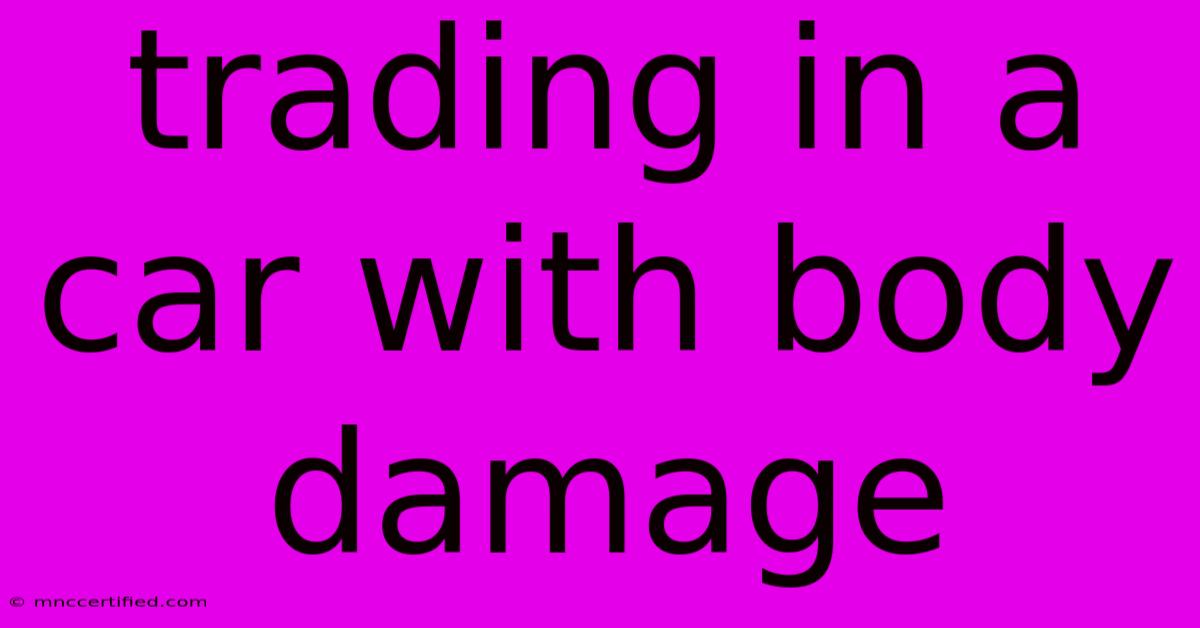Trading In A Car With Body Damage

Table of Contents
Trading in a Car with Body Damage: A Complete Guide
Trading in a car, especially one with body damage, can feel daunting. The process isn't as straightforward as trading in a pristine vehicle, but with the right approach, you can still get a fair deal. This comprehensive guide will walk you through the entire process, from assessing the damage to negotiating the best price.
Assessing the Damage: Knowing Your Car's Worth
Before you even step foot on a dealership lot, accurately assessing your car's damage is crucial. This affects how much you can realistically expect to receive as a trade-in.
Identifying the Extent of the Damage
Carefully inspect your vehicle for all types of damage:
- Scratches and Dents: Minor scratches and dents might not significantly impact the value, but larger or more numerous ones will.
- Broken Parts: A broken headlight, cracked windshield, or damaged bumper will considerably lower your trade-in value.
- Structural Damage: This is the most serious type of damage and can dramatically reduce or even eliminate your car's trade-in value. It involves damage to the frame, affecting the car's safety and structural integrity.
- Rust: Extensive rust significantly diminishes the value, especially if it's impacting structural components.
- Paint Damage: Significant paint damage, beyond minor scratches, will lower the value.
Getting an Independent Appraisal
Consider getting an independent appraisal from a trusted mechanic or auto body shop. This provides an unbiased assessment of the damage and its cost to repair. This appraisal serves as strong evidence when negotiating with dealerships. Having this report in hand strengthens your position.
Preparing for the Trade-In Process
With your damage assessment complete, you're ready to prepare for the trade-in process.
Gather Necessary Documents
Gather all relevant documents, including:
- Vehicle title: This proves ownership.
- Vehicle registration: Shows current registration status.
- Repair estimates (if applicable): Independent appraisals will support your negotiation.
- Maintenance records: Demonstrates proper car care.
Research Trade-In Values
Use online tools like Kelley Blue Book (KBB) and Edmunds to research the trade-in value of your vehicle. Remember to adjust the value downwards to account for the body damage. Be realistic; dealerships will likely offer less than the private party sale value.
Consider Repairs (Weigh the Pros and Cons)
Repairing the damage before trading in might seem like a good idea, but it's not always the best financial strategy. Weigh the cost of repairs against the potential increase in trade-in value. Sometimes, the cost of repair exceeds the resulting increase in value.
Negotiating with the Dealership
Negotiating a trade-in with body damage requires a strategic approach.
Be Transparent About the Damage
Don't try to hide the damage. Be upfront and honest about the extent of the damage and provide the independent appraisal if you have one. Transparency builds trust.
Highlight the Vehicle's Positive Aspects
While focusing on the damage is necessary, remember to highlight the vehicle's positive aspects, such as low mileage, good mechanical condition, or desirable features.
Negotiate the Price Aggressively (but Respectfully)
Be prepared to negotiate firmly but respectfully. Know your bottom line and don't be afraid to walk away if the offer is unacceptable. Remember that dealerships have room to negotiate.
Explore Alternative Options
Consider selling your car privately to maximize your return, especially if the damage is extensive. You might get a better price by selling privately, even with the imperfections.
Conclusion: Maximizing Your Trade-In Value
Trading in a car with body damage requires careful preparation and strategic negotiation. By accurately assessing the damage, gathering necessary documents, and being transparent with the dealership, you can significantly improve your chances of getting a fair deal. Remember, knowledge is power, and preparation is key to a successful trade-in. Don't be afraid to walk away if the offer isn't in your best interest. There are always alternatives.

Thank you for visiting our website wich cover about Trading In A Car With Body Damage. We hope the information provided has been useful to you. Feel free to contact us if you have any questions or need further assistance. See you next time and dont miss to bookmark.
Featured Posts
-
Madison Man Missing Hunters Needed
Nov 23, 2024
-
Does Mochi Health Take Insurance
Nov 23, 2024
-
Investment Boost Liontrusts New System
Nov 23, 2024
-
Euro Millions Megadraw November 22 Results
Nov 23, 2024
-
Coverage Diamond Auto Insurance
Nov 23, 2024